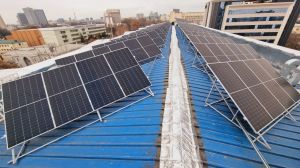Uzbekistan is capable of meeting its energy needs from its own energy resources. Uzbekistan owns a significant part of the installed capacity of the united power system of Central Asia.
The specifics of the technological process of production, distribution and consumption of electricity make it necessary to maintain centralized management, with joint-stock companies, such as Thermal Power Plants, National Electric Networks of Uzbekistan and Regional Electric Networks, under the Ministry.
In 2018, the power plants of Thermal Power Plants JSC generated 56.3 billion kilowatts of electricity and released 7.5 million Gcal of thermal energy. The total installed capacity of power plants in Uzbekistan is more than 14,000 MW.
Transmission of electrical energy from the generating sources of Thermal Power Plants JSC to the distribution and sales enterprises of Regional Electric Networks JSC is carried out by National Electric Networks of Uzbekistan JSC through its main electric grids with a voltage of 220-500 kV and a total cable length of more than 9.7 thousand km.
The supply of electric energy to consumers nationwide is the responsibility of the electricity grids of fourteen territorial distribution and sales enterprises, which operate in each territorial entity as joint-stock companies under the control of Regional Electric Grids JSC. On the balance sheet of each enterprise are power transmission lines with a total length of more than 250 thousand km, and 1,700 substations with an aggregate voltage of up to 110 kV.
The most extensive, with a length of more than 224 thousand km, are electric grids 0,4-6-10 kV, which are mainly used to supply power to consumers nationwide.
Thermal Power Plants JSC, Main Electric Networks of Uzbekistan JSC and Regional Electric Networks JSC are jointly responsible for the design, construction, installation and commissioning works in conjunction with the repair and maintenance of the main equipment and accessories of power plants and grids.
The presence of a developed production base and qualified personnel allows us to maintain a high level of operation of energy facilities.
In accordance with a Resolution of the President of the Republic of Uzbekistan on the strategy for further development and reform of the electricity sector of the Republic of Uzbekistan, the Ministry is developing a programme for the development of generating facilities for the period up to 2030 providing for the implementation of major investment projects to increase generating capacity with the construction of new power units with total capacity of about 27 GW for a total of about 35 billion U.S. dollars, and the decommissioning of obsolete power units at thermal power plants with a total output of 6.4 GW
The implementation of measures in the thermal power industry will ensure the introduction of modern energy production technologies based on highly efficient steam-gas and gas-turbine units with the efficiency of power units reaching about 60%.
Special attention is being given to the construction of the country's first nuclear power plant with an output of 2.4 GW.
Also, as part of the transition to a “green" economy, priority in the electric power sector is being given to the establishment of modern solar and wind power plants with a total output of 6.7 GW.
To ensure stable supply of electricity, it is also necessary to build 2.7 thousand km of 220-500 kV transmission lines with the simultaneous construction of 9 new substations, which will require an investment of $ 2.4bn.
Furthermore, $ 9.9bn is required for reconstruction and modernization of 39,600 units of existing transformer substations and 140,900 km of power transmission lines in distribution grids of 110/35/10/0. 4 kV.
Naturally, the investment needed in the electric power sector cannot be made only at the expense of existing government-owned energy companies, and we will focus on attracting private investment.
There are also plans to build new power plants with a total output of 15 GW exclusively through direct investment amounting to about $ 17.3bn. All plants, with the exception of hydroelectric, nuclear and several regulatory power plants, will be built through direct investment.
These will include:
- Construction of a new power plant in the Syrdarya Region based on a combined-cycle plant in two stages of 1,300 MW each;
- Construction of a new power plant based on a combined-cycle plant with a total output of 850 MW in the Tashkent Region by the Turkish company Cengiz Enerji;
- Construction of a new power plant based on a combined-cycle plant with a total output of 900 MW in the Surkhandarya Region by the Turkish company Yildirim Enerji;
- Expansion of Navoi TPP with construction of CCP-3 and -4 with an output of 650 MW each;
- Construction of regulating power plants based on a combined-cycle plant and gas reciprocation engines.
In the future, the preferred strategy is to sell part of the shares in these power plants to private investors and create joint ventures on a PPP principle.
The step-by-step reform of the electricity industry is designed to meet the growing demand of the economy and the population for electric energy without a sharp increase in tariffs.










